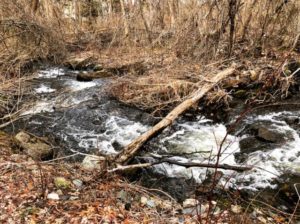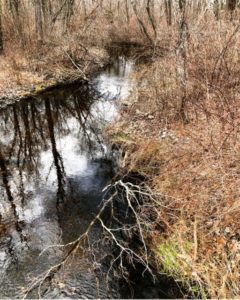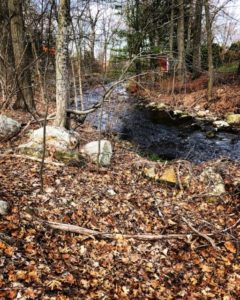I had the opportunity to collaborate with the Neponset River Watershed Association and Greater Boston Trout Unlimited.

It is an interesting project to identify and learn more about wild trout streams in the Metropolitan Boston area in an effort to raise awareness for, and protect, these unique resources.

Wait, wild trout streams in the metro area? Exactly.
It’s pretty incredible that we have over a dozen cold-water streams within 20 miles of downtown Boston. Most are populated with wild, native Brook Trout. Some have naturally-reproducing Brown Trout.
What’s even more incredible is that these fish have been able to hold on even in the face of literally hundreds of years of human encroachment in the watersheds and riparian areas that are so critical to their well-being.
Several of these streams are quite prolific, with dense populations of trout and some surprisingly large fish in certain cases. Currently, for the most part, many of these metro streams are pretty limited as fisheries: private land, no trespassing signs, and lack of public parking.

Still, there are a few locations where an angler can access portions of these urban streams.
In all honesty, these streams are extremely important resources to protect regardless of their utility as recreational fisheries. However, it would be great to provide some sort of access.
What other city, especially with the population density of Boston, has wild trout streams one can conceivably fish without even leaving sight of the downtown skyline?

Must be protected. I know one is in danger of building. But it might be a chance to get some help from the builders to protect this area.
A local TU chapter can work with landowners to encourage access, sometimes land trusts can negotiate easements donated by landonwers, lots of things to do.
Fantastic idea!
Adam, great post! I’d imagine aquifers are pretty critical for the areas that do hold trout?
Thanks Jo! For the most part groundwater is going to be quite important. So limiting groundwater withdrawals could prove important for maintaining flows and water temperature. But there are so many other things as well. Maintaining riparian buffers for shade, energy input, and runoff attenuation. Rethinking how stormwater is routed so streams don’t experience such flashy flows or superheated runoff from streets and parking lots. Curbing sediment from construction projects, bank erosion, sand from roadways, etc. And these are just some of the major issues that Brook Trout in more developed areas have to endure!
Awesome post Adam! I know several “urban” streams around southern NH. It’s sad to see how degraded they are, but it’s amazing to see how well brook trout hold on. I have a friend who worked for the DES who said that some “gentleman” was yelling at him for wasting his tax dollars electrofishing a stream that supposedly had “no fish.” As it so turns out, this nameless stream was chock full of wild brookies of multiple age classes.
I hope one day, people are more aware of the beautiful natural resources around them and stop taking them for granted.
Thanks Ashu, I agree, it is pretty amazing the places where one can find Brook Trout in developed areas.
Have you ever fished any of these “urban” streams Ashu?
I’ve fished a few. There is one stream near Durham that flows through an active residential development. I walked/fished it briefly last summer. It was ugly to say the least. The bottom was silted up badly due to the active logging happening just upstream. Still, it held fish despite all its problems. There are a number of streams near my house that hold brookies as well. Fortunately, the land around them is protected and they are not nearly as bad as that small stream near UNH. Still, people are incredulous when I tell them that they are trout streams.
It is amazing to me that wild trout survive so close to downtown Boston. Our native trout are very tough and are true survivors if given half a chance to continue on. As I travel around I see many small streams and have come to believe that many have at least a few trout surviving in them.
You’re right Sam Brook Trout are pretty resilient. As long as the water is cold enough they can put up with a lot. Not that they necessarily thrive under these disturbed conditions but they can persist. I think that we would rather see them thrive though and that is what is going to take a larger effort in many cases. You are also probably correct in assuming that many of the small streams you cross over are inhabited by Brook Trout. We do have over 1200 individual streams with wild, naturally-reproducing Brook Trout. That’s a lot for such a small state.
“We do have over 1200 individual streams with wild, naturally-reproducing Brook Trout. ” That’s Amazing.
Work brought me to my home office today in the Boston area. I needed a few fly tying items so I stopped by the Orvis store in Dedham. What nice folks that work there. They were well aware of the cold water streams in the Boston area when I brought that subject up. Hard to fish or gain access to from what I understand being many are on private property, Cynthia showed me a picture of a big brown trout she caught on the Hooosic last year. Must have been 4 pounds.
A great fly shop!
How do you best recommend going about learning about these areas? Didn’t even know about GBTU, I’ve reached out to ask about membership.
GBTU is a good start. Also, feel free to get a hold of me whenever Jon.